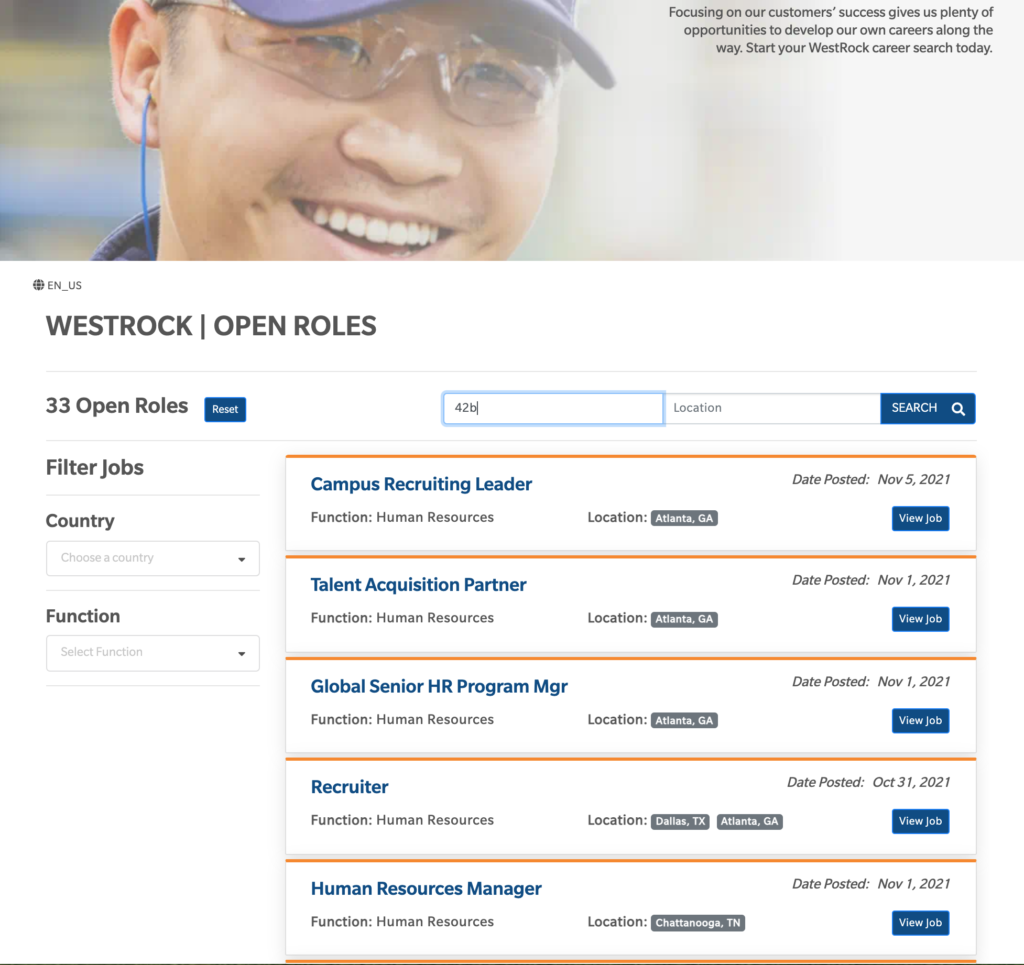Did you know veterans are 37% more likely to be underemployed than non-veterans according to the NY Times? Here are 7 tips we found for recruiting veterans:
1. Set goals for recruiting veterans
Setting a diversity goal is key if you want to get results for recruiting veterans.
The great thing about setting goals for hiring veterans is that the veteran community is quite diverse as well. The U.S. Census in 2018 found that:
“About 17 percent are women, 15.3 percent are Black, and 12.1 percent are Hispanic.”
So veterans recruiting goals also stretch across other underrepresented groups.
Here’s HP Inc.’s newest diversity goal:
“increase the growing percentage of hiring from underrepresented communities — including women, minorities, veterans, and persons with disabilities” (by 2025).
The results? HP’s 2019 Sustainable Impact Report shows they:
- Exceeded their 2016 diversity goal for hiring veterans and veteran spouses by 43%
- Made the list of the top veteran-friendly companies list
- Spent $18 million with veteran-owned and service-disabled veteran-owned businesses
Target also set a goal of recruiting veterans as a part of the Veterans Jobs Mission. Target and the companies below have been working to meet a goal of hiring 1 million veterans and their spouses by 2020 (a doubling for most companies).

Another possible goal to set for recruiting veterans is to launch new training options for employees who participate in the hiring process. An article from Military.com, 5 Recruiting Tips for Attracting Veterans, says to provide your recruiters with training to better understand military skillsets, experience, and terms. This helps keep the door open to potential veterans whose military experience may not translate well on paper.
(note: For a list of other companies setting diversity goals for recruiting, check out our blog 25+ Examples of Awesome Diversity Goals)
2. Highlight veterans on your career page
Not only does HP, Inc. have a diversity goal to hire more veterans, but they also highlight veterans on their website. This diversity video shows HP employees, talking about their experience working at HP as a veteran. It also touches on what to ask and what not to ask veterans in an interview.
If you have a goal to hire more veterans, a tool like Career Site Builder can help. The tool allows you to add videos (like the one above), images, or a dedicated recruiting veterans landing page to your career site. Recruitmilitary.com says:
“The right branding can inform diverse candidates, including potential veteran hires, that your organization will value their talents and contributions.”
U.S. Veterans Magazine said:
“Numerous organizations offer specialized websites for veterans, including AT&T, Amazon, Disney, JPMorgan Chase, Microsoft, Sodexo, T-Mobile, and Walmart Inc.”
Your career page connects you with potential candidates, so why not share a message that resonates with military veterans.
3. List job perks that attract veterans in job descriptions
Job descriptions are the perfect place to list job perks that attract veterans. When veterans are searching for job postings, they will look for perks that are inclusive to their experience, needs, and growth at a company. List things like:
- company culture and values (important for veterans)
- mentorship or leadership development programs for veterans
- growth potential
- relocation programs for veterans and their families
- area attractions
- company ERGs for veterans
- programs for veteran spouses and partners
An article from SHRM on 8 Ways to Attract and Keep Veterans highlighted a few companies that excel based on the list above. AT&T has had success in recruiting military veterans. The article said that AT&T’s veterans ERG has more than 9,000 employee participants and the company connects veteran mentors with veterans who are new hires to create a feeling of belonging. Imagine if this was highlighted in a job description!
A tip on job descriptions from Monster on how to hire veterans is:
“Ensuring that your job description explains responsibilities in detail, uses relatable language, and lists familiar skills will allow the veteran to understand how their skills and experience are applicable and transferable to the position. For example, your job posting could emphasize the need for candidates with leadership or problem-solving skills, adaptability to change, communication skills, experience working with diverse groups, or technical skills.”
4. Create a referral program for recruiting military veterans
Internal programs for recruiting veterans for jobs is another way to boost veteran hiring. Video interviewing company, WePow, Inc. says one of the best strategies for attracting veterans to your company is through internal referrals. WePow said:
“Sometimes your best source of veteran talent can be the people sitting just a few feet from you. Most companies should have at least some employees with a military background, try asking them if they know anyone that would be a good fit for any open positions. To motivate them even more, consider offering them a monetary incentive for each military professional they refer that is successfully placed.”
Referral programs for recruiting veterans are not only for people with a military background. Organizations and universities like the ones listed below offer external referral programs too:
- The University of Southern California — allows any faculty or staff employees to suggest a military veteran for a position. If the veteran is chosen, the employee gets a $200 bonus from the university.
- Georgia Department of Labor — provides job referrals to their own job postings, so employees can refer veterans for regular job openings.
- AbleVets — pays $3000 to referees once a veteran is successfully accepted for a job.
5. Use job boards for veterans or a military career placement firm
If you want to look for candidates externally, 2 veterans recruiting services to use are job boards and military career placement firms.
A veterans job board is a great place to post open positions if you are recruiting veterans. Here are a few popular veterans job boards listed on Hiring America’s website:
- HireVeterans.com
- Military Hire
- Military.com
- Vet Jobs
If you have room in your budget, you can also hire a military career placement firm like Orion Talent. Trey Grissom, Account Executive at Orion Talent and Marine Corps Infantry Veteran, says when recruiting veterans:
“Culture and purpose are the two things that are most important. Veterans come from an environment of structure, comraderie, and purpose. Finding a company with the same values and culture is key.”
Veterans recruiting services, like Orion, provide solutions for employers based around that, which include:
- Military talent programs
- Military hiring events
- Military search & staffing
- Veteran outreach and candidate matching
6. Avoid using corporate speak and acronyms
Veterans may not understand corporate speak or acronyms…and the military has a jargon of its own. So it’s best to avoid them when writing job descriptions.
“For veterans who are transitioning into the civilian workforce, there is just as much, if not more, confusion in trying to decipher the language of business than there is for you to decipher the language of the military.”
source: Harvard Business Review
When you list job requirements or daily tasks keep it simple. You can leave out things like “manages a matrix of KPIs” and “must have experience with SOWs and MSAs”.
7. Use military job codes to your advantage
Veterans and enlisted military know jobs in terms of “military job codes” or “mos” codes. You can list them in your job postings or even better, incorporate them into the search on your careers page using AI Job Search technology from Google’s Cloud Talent Solutions. Doing this boosts your chances of reaching candidates who are veterans, or soon to be.
For example, if you search Westrock careers for mos code “42b”, you get a list of job openings in the HR job family. MOS 42b is the “Human Resource Officer” position in the military:

You can find more about adding AI job search (with mos codes for hiring veterans) in our post A Secret & Easy Way to Recruit Veterans from Your Career Site.
WHY I WROTE THIS
Ongig supports diversity in the hiring process, this includes recruiting veterans. If you want to learn more about creating a dedicated veterans page on your career site click our demo request button to learn more about Career Site Builder.
Shout-outs
- Veterans Are Working, but Not in Jobs That Match Their Advanced Training (by Jennifer Steinhauer)
- A GUIDE TO IMPROVING YOUR DIVERSITY RECRUITING STRATEGY (by RecruitMilitary)
- 12 Great Online Resources for Veterans Looking for Jobs (by Hiring America)
- Orion Military Talent Solutions
- Trey Grissom, Account Executive at Orion Talent and Marine Corps Infantry Veteran
- Military-ready Employer Tool Kit (by SHRM)
- 5 Recruiting Tips for Attracting Veterans (by Lida Citroën)
- Veterans Who Have Served Since 9/11 are More Diverse (by Kelly ann Holder)
- 8 Ways to Attract and Keep Veterans (by SHRM)
- How to hire veterans: 5 quick tips (by monster.com)
- Attracting And Sourcing Veterans—Help For Corporations Looking For The Right Veteran For The Job (by U.S. Veterans Magazine)
- The Best Strategies for Attracting Veterans to your Company (by WePow, Inc.)
- Best Job Referral Programs In The Us For Vets (by VetReady)
- Hiring Veterans Is Good Business. So Why Don’t We Do It More Often? (by Derek Bennett)
